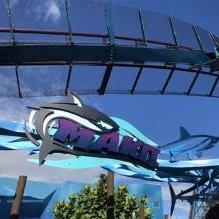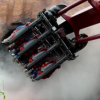Leaderboard
Popular Content
Showing content with the highest reputation on 07/24/24 in all areas
-
How accurate are advertised ride queue times?: A statistical analysis using data from Alton Towers and the UK Merlin parks
Disclaimer: This is a long, geeky post. If you don't like statistics or maths talk, turn back now! If you'd like a more concise summary, a TL;DR can be found at the bottom. Hi guys. When you go to a park, you will often see advertised queue times all over the place to help you determine how long the ride queues are. But sometimes, you might find that these do not necessarily tell the truth. At times, you might get in a queue with a reasonable advertised time and wait far longer than expected, and at other times, you might get in a queue with a long advertised time and wait far less than expected. With this in mind, you might be wondering; how accurate actually are these advertised queue times? Can they be relied upon? Or are they largely hokum? Well, dear reader, that is the question I'm aiming to answer today. Through the power of statistics, I am going to work out; how accurate are advertised queue times? Let's firstly start with the methodology of my statistical analysis... Methodology You might be wondering "Matt, how on Earth are you going to get hold of advertised and actual queue time data to conduct this analysis?". Well, the answer to that is that I had an idea... for years, I've been writing trip reports from various theme parks, and within these, I often make reference to the advertised queue time and how it compared to the actual queue time. And I was thinking that I could use my anecdotes from some of these trip reports as samples for the analysis. Yes, there's finally a day where my comparisons of advertised and actual queue times come in handy! My method entailed reading my various trip reports from the UK Merlin parks from over the years and looking for anecdotes referring to the advertised queue time in comparison to the actual queue time of a ride. I chose the UK Merlin parks because these are where I have by far the most data from, and they are also likely to share similar technology, processes and the like for determining advertised queue times, which removes any uncertainty from working with companies with differing processes. I should note that I did not count every time I went on a ride. I only counted rides where there was one of: An explicit comparison between advertised queue time and actual queue time given. A comparison between advertised queue time and actual queue time that heavily hinted towards the actual queue time given. For instance, words like "walk-on" or "I waltzed straight onto the train" would infer a 0 minute actual queue time, and words like "the queue time board stayed true to its word" would infer no discrepancy between the advertised and actual queue times. There were rides I did not count, as I felt that they would not be representative of the actual main queue. These are: Any time where I talk about using a Single Rider Queue or otherwise benefitting considerably from single rider status (such as being called to walk past a long queue to fill an empty seat). Any time where I talk about using Fastrack or similar. Any time where I talk about waiting longer for a specific experience, such as the front row. Through these rules, I was able to gather: 15 days and 75 rides of data from Alton Towers, dating back as far as 23rd June 2019 9 days and 48 rides of data from Thorpe Park, dating back as far as 6th May 2018. 3 days and 9 rides of data from Legoland Windsor, dating back as far as 31st August 2017. 1 day and 3 rides of data from Chessington, from 17th September 2023. I should also give a few caveats. These are: This is my data and mine only. There are multiple reasons why that means that it may not be a fully representative sample. For example, Chessington and Legoland are under-represented, whereas Alton Towers and Thorpe Park are over-represented. The actual level of understatement may be higher than what this analysis suggests, as this only factors in queues I have personally waited in. If a queue looks vastly understated at first glance, there's a good chance I won't join it. Where I provided a range of time for the actual queue length, I went with the upper bound. For example, if I described a queue as taking 20-25 minutes, I logged the actual queue time as 25 minutes. I should strongly emphasise that this is not a massively exact science. The measurement of actual queue time was me looking at my watch throughout the queue, and for a variety of reasons, the movement of a queue can be affected in ways that the advertised time can't account for. With this out of the way, let's move onto the actual meat of the analysis... For each part of the analysis, I'll look at an individual park, as well as all 4 Merlin parks amalgamated together. For the individual park, I picked Alton Towers, as this is the park for which I have the most data. Let's start with a simple correlation analysis to determine the strength of the relationship between advertised queue time and actual queue time... Correlation For those not aware, the correlation between two variables determines whether or not they are inter-related. The magnitude of a correlation lies between 0 and 1, with 0 indicating no correlation and 1 indicating a perfect strong correlation, and a correlation can also be positive or negative. A positive correlation means that as the value of one variable rises, the value of the other rises in unison, while a negative correlation means that as the value of one variable rises, the value of the other falls. Now that I've explained a bit about correlation, let's have a look at what the data says about the correlation between advertised queue time and actual queue time! I'll consider two different correlation coefficients, Pearson and Spearman. Pearson's correlation coefficient assumes a linear relationship between two variables, whereas Spearman's correlation coefficient does not. If we look at Alton Towers on an individual level, the scatter graph of advertised queue time and actual queue time looks something like this: And the correlation figures are as follows: Correlation Type Correlation Coefficient (2dp) Correlation Classification Pearson 0.67 Moderate Positive Correlation Spearman 0.74 Moderate Positive Correlation Whereas if we look at the UK Merlin parks overall, the scatter graph of advertised queue times versus actual queue times is as follows: And the correlation figures are as follows: Correlation Type Correlation Coefficient (2dp) Correlation Classification Pearson 0.65 Moderate Positive Correlation Spearman 0.70 Moderate Positive Correlation So if we look at correlation, I think we can conclude that there is a relationship between advertised queue time and actual queue time. Based on correlation alone, we can infer that on a general level, there is a moderate-to-strong correlation between advertised and actual queue time, so if the advertised queue time increases, you can generally expect actual queue time to increase along with it. However, the correlation is far from a perfect positive correlation, so this will not be the case in every scenario. In fact, the fact that the positive correlation does not even quite breach the threshold of "strong" (which I was told was 0.75) would suggest that this is not always the case by a long shot, and the relationship is far from perfectly proportional. So in general, the correlation analysis would suggest that the advertised queue times are trustworthy to a broad extent to get a gauge of the broader picture, but perhaps with a notable margin of error for exact figures. Let's now look at the average discrepancy... Discrepancy (Vector) Let's now look at the average discrepancy as a vector quantity. Vector quantities have both magnitude and direction, so this form of discrepancy will consider whether the queue is overstated or understated as well as its actual magnitude. Where the queue is overstated, the discrepancy is negative, whereas the discrepancy is positive where the queue is understated. If we firstly look at Alton Towers on an individual level, here are the boxplots showing the ranges of raw and proportional discrepancies respectively. It's important to consider proportional discrepancy because if an advertised queue time is longer, there's bound to be a larger discrepancy in general: And the raw and proportional discrepancy stats, as well as average queue time, are as follows. Both mean and median values are provided, as each metric has flaws in isolation and I felt that showing both offered maximum transparency: Average Advertised Queue Time (minutes, 1dp) Average Raw Discrepancy (minutes, 1dp) Average Proportional Discrepancy (1dp) Adjusted Average Proportional Discrepancy (1dp) Mean (Calculated Average) 28.3 2.2 8.8% 7.8% Median (Middle Value) 25 0 0% 0% I should clarify that Average Proportional Discrepancy is the average of the proportional discrepancies listed alongside each anecdote, which excludes those where the advertised queue time was 0 minutes and the actual queue time was a different number (you cannot divide a non-zero number by 0, so a percentage proportion cannot be provided). Adjusted Average Proportional Discrepancy is a simpler calculation of Average Raw Discrepancy as a share of Average Advertised Queue Time on an overall basis, which (sort of) takes these into account. If we now look at the UK Merlin parks overall, here are the boxplots showing the ranges of raw and proportional discrepancy respectively: And the raw and proportional discrepancy stats, as well as average advertised queue time, are as follows: Average Advertised Queue Time (minutes, 1dp) Average Raw Discrepancy (minutes, 1dp) Average Proportional Discrepancy (1dp) Adjusted Average Proportional Discrepancy (1dp) Mean (Calculated Average) 26.1 1.3 13.7% 5.1% Median (Middle Value) 25 0 0% 0% So looking at this, Alton Towers and UK Merlin queue times are understated by up to 1-2 minutes on average. If we look at the median, that would imply that there's no discrepancy between advertised and actual queue time at all on average, and even the higher mean values infer that there are average discrepancies of less than 10% in some cases. At face value, these stats would give reason to believe that Merlin's advertised queue times are very accurate overall, with an average error of only 1-2 minutes and less than 10%. However, you should note my use of the term "at face value"... because that's not the full picture. You might remember that earlier, I said about how the discrepancy being shown here is a vector quantity, meaning that it has both magnitude and direction. That means that understated queues have a positive discrepancy value and overstated queues have a negative discrepancy value, so the two balance each other out. So while you'd think that the low average discrepancies shown here mean that the queue times are very accurate... the use of vector discrepancies here mean that all this really shows is that understating and overstating balance each other out quite nicely, meaning that you can't really rely on Merlin parks to understate or overstate their queues. They both understate and overstate to broadly equal extents. To get the true picture of how accurate these queue times really are, we need to convert the discrepancy values into a scalar quantity and look at the absolute values of discrepancy... Absolute Discrepancy To get the true gist of how accurate these queue times really are, let's now look at the absolute discrepancy values. Absolute means that only the magnitude of discrepancy is considered, and that the discrepancy values are scalar quantities rather than vector quantities. If we firstly look at Alton Towers on an individual level, the boxplots showing the range of raw and proportional absolute discrepancy values are as follows: And the raw and proportional absolute discrepancy stats, as well as average queue time, are as follows: Average Advertised Queue Time (minutes, 1dp) Average Raw Absolute Discrepancy (minutes, 1dp) Average Proportional Absolute Discrepancy (1dp) Adjusted Average Proportional Absolute Discrepancy (1dp) Mean (Calculated Average) 28.3 14.1 39.3% 49.6% Median (Middle Value) 25 10 27.5% 40% If we look at the UK Merlin parks overall, the boxplots showing the ranges of raw and proportional absolute discrepancy are as follows: And the raw and proportional absolute discrepancy stats, as well as average queue time, are as follows: Average Advertised Queue Time (minutes, 1dp) Average Raw Absolute Discrepancy (minutes, 1dp) Average Proportional Absolute Discrepancy (1dp) Adjusted Average Proportional Absolute Discrepancy (1dp) Mean 26.1 13.5 58.7% 51.6% Median 25 5 33.3% 20% So looking at these stats, UK Merlin queue times are wrong by 5-15 minutes on average, and broadly, the average proportional absolute discrepancy ranges between 20% and almost 60%. This would imply that the advertised queue times are not phenomenally accurate, and may not be 100% correct in terms of the exact figure on average. However, it would suggest that they are still quite good at a more general level to get a general gauge of how long a queue might be. If a queue is advertised at 100 minutes, it's unlikely to be walk-on, and vice versa. These figures suggest that the advertised queue times can generally be used as a broad gauge of the length of the queue, but should not be taken as gospel and the exact figures should be taken with some degree of caution. Let's now look at some final conclusions... Conclusion So in conclusion, how accurate are these advertised queue times? Well, I think these results show that they're overall reasonable as a gauge of the broad ballpark the queue time is likely to fall into, but have somewhat weaker accuracy at determining exact queue times. In terms of the correlation analysis, the advertised queue time and the actual queue time have a reasonable correlation, but not a perfect one. The two are moderately positively correlated, with a correlation coefficient of around 0.6-0.7, which would suggest that the two variables are broadly related and do increase in unison with one another in general, but this is far from a perfectly proportional increase and is not a perfect rule by any means. On average, the vector discrepancy between advertised queue time and actual queue time was to be understated by 1-2 minutes, and the percentage margin of error was often to be understated by less than 10%. This suggests that understating and overstating overall happen to roughly equal degrees, and you can't really rely on Merlin to reliably do either. On average, the absolute discrepancy between advertised queue time and actual queue time was 5-15 minutes, and the percentage margin of error for the advertised queue time was between 20% and 60%. This would suggest that the advertised queue times are rarely 100% accurate and should be treated with a degree of caution and a margin of error, but that they're generally decent as a way of gauging broadly how long a queue will be. If a queue is advertised at 30 minutes, for example, you can assume that it will probably be between about 15 minutes and about 45 minutes. That is quite a wide margin, admittedly, but the advertised queue times are unlikely to be amazingly wrong, on the whole. A 30 minute advertised queue, as an example, would indicate a roughly "middle of the road" queue time with a reasonable degree of reliability; the queue is unlikely to be obscenely short, but it's unlikely to be obscenely long as well. So in conclusion, I think this analysis suggests that the advertised queue times are decent for getting an idea of broadly how long a queue is likely to be, but are worse at pinpointing the actual exact queue time, and the estimates should be considered with a good margin of error and not taken as exact estimates. If you'd like to look at my data, here are the full spreadsheets for Alton Towers and UK Merlin queue times respectively: https://docs.google.com/spreadsheets/d/1c2b05czi2xwwDxKRVBMJ9qyB3_-_b0RyMdc-N8n8JJI/edit?usp=sharing https://docs.google.com/spreadsheets/d/1jpqqpu2pErHY41vHTpDP_NEZqnjuMwgtVVp99JexjvI/edit?usp=sharing So that brings us to the end of this statistical analysis! I hope you enjoyed reading it as much as I enjoyed concocting it, and I hope you found it interesting! I'd be really interested to hear your thoughts; I'm receptive to any feedback, good or bad! TL;DR: I performed a statistical analysis to try and determine how accurate advertised queue times are, using datasets of advertised vs actual queue times in Alton Towers and the UK Merlin parks taken from my past trip reports. A correlation analysis showed that there was a moderate positive correlation of magnitude 0.6-0.7 between advertised and actual queue time, indicating that they do generally increase in unison, but that this is far from a perfect trend and this is not necessarily a proportional increase. An analysis of average vector discrepancies showed that Merlin parks do not reliably understate or overstate queue times, with both understating and overstating happening to broadly equal degrees. An analysis of average absolute discrepancies showed that the queue times can provide a broad idea of roughly how long a queue may be, but are unlikely to be too accurate at determining the exact queue time.1 point
-
Kings Island
1 pointI'm sure you've all heard of Kings Island. It's a part of the Six Flags chain now, but in June it was one of the premier Cedar Fair parks, sitting right under Cedar Point as one of its main gems. Its line up also reflects this with three B&M's, a GCI, an Arrow, classic woodies and several classics and frequent investment that Michigans Adventure could only dream of. Before my visit I heard about the fantastic operations, full train operations, how they operate the park flawlessly. Well spoilers. They don't. I recently embarked on a 9 park USA trip and out of all of them, Kings Island sits as the most disappointing. But why? There's several reasons but first let's start with the rides themselves. The five main attractions are Diamondback, Orion, Banshee, Mystic Timbers and the Beast. Like Canadas Wonderland & Carowinds, the park has a hyper/giga combo and in my opinion this is the weakest combo of the three. Diamondback is the hyper coaster and is the best coaster in the park. It has a lot of air time, it has the second best layout (Behemoth, Diamondback and Thunder Striker) and is generally well paced and landscaped. Orion is pretty good but is too short. It also doesn't share the same principles as Fury 325 and Leviathan. Those two rides despite being gigas, keep relatively low to the ground and have fast paced corners interspersed with good floater air time. Orion on the other hand feels like it's missing the last third of the ride. It has a strong two thirds but hits the breaks way too early. It's a shame because it has good air time hills and an intense helix. I know some may say that I should enjoy what a ride and not what it doesn't. Too some extent I agree. However I rode Fury 325 a week earlier and that is a complete ride. Orion just lacks that something. And finally Banshee. I feel fortunate to have got on this, a week prior to my trip, a guest had actually got into the ride area and was killed by a train. I found Banshee incredibly disappointing actually. It is a huge B&M invert with a beautiful colour scheme but my god it is so forceless. I don't really understand how they went from Oz'Iris which is a top tier invert, to this in just two years. I had two rides on Banshee and neither really did anything for me. The only bit I really enjoyed was the slow zero-g roll at the end of the ride. I can't even say that the restraints were the problem because they weren't. Banshee is the only Invert to feature the new restraints. Here the ride lacked that kick that inverters like Nemesis, Katun and Afterburn feature, that whippiness and aggressive pacing that takes them to the next level. I'd heard fantastic things about Mystic Timbers and to be fair this is pretty good. I liked the way the ride goes off into the woods (which is a very popular American woodie feature) and I liked the pacing. The shed itself is naff though and it feels like it's done purely because the train has to sit in the break run for 60 seconds so they attempted a show element. The Beast is probably Kings Island most iconic ride and we'd heard all about the legendary night rides. We only rode this at night for context so I couldn't really tell you what the layout does without watching a POV. It was absolutely class at night though. There's clearly an aura around this ride and night rides are legendary. Hundreds of people waiting way after 11pm to get on this ride. IMO it didn't disappoint and was a highlight of the trip. There's something so peaceful and yet nerve wracking about being on a ride and not having a clue of where you are going. It's just you, the stars and the night sky following you and the 35 other people traversing through the woods. It felt like a proper moment where theme park passion comes alive and you get off feeling so much better for having done it. With the highlights ticked off, next comes the lesser talked stuff. The Bat is an arrow suspended and is my least favourite of the five remaining. It never felt like it got going and lacked the swing that Vortex (at Canadas Wonderland) or Vampire has. Invertigo never opened and hasn't been open since my visit so that could be dead. The two wooden duelling coasters named Racer were excellent and the park clearly looks after them as they rode fantastically. Adventure Express was a very good arrow mine train, with actual theming and a non janky, exciting layout. I love an arrow mine train and each one is so different from the last. Truly unique. Backlot Stunt Coaster was just like the other two I have ridden, this one did have working effects though which makes a difference. Flight of Fear was fine, apparently reopened after track welding work. It's not a favourite but its relatively well themed and has a good layout. The new ride, Snoopys Car thing, was a good Vekoma boomerang and there was a good level of kiddy coasters in this area with Woodstock Express and Woodstocks Air Rail. On the face of it the rides aren't the problem so what exactly was it that wasn't clicking about the park? Well simply put, I think whilst the park does run full capacity on rides and it does have very engaged ride teams, I don't think the way they operate their rides is particularly effective. For example the team absolutely blitz it down ride platforms, shouting to lift lap bars when trains park. But sometimes this frantic, over the top activity just creates confusion for park guests and puts them on edge. You stress out a park guest, they start to behave in odd ways. They start to do things like exit vehicles in the wrong way. They don't do seat belts up, they may try to walk up lift hills. It also starts to throw off other park employees. One example I have is we were waiting front row on Diamondback and we were told we wouldn't be on the next train because of disabled guests. Okay fine. But the disabled guests never turned up. The platformers just put the bars down, in their frantic race to roll trains. The miscommunication, the frantic action meant groups who have positioned themselves to ride together are thrown off, it means a premier seat goes out empty (one you are waiting longer for anyway) and to me is not good park operation. Just rolling out trains is no good if you aren't effectively filling the trains to maximum capacity. The other gripe I have is the idea that running three trains is how you deal with capacity but actually, the rides are effectively designed to have a train sit on the break run for 2 minutes whilst the one in the station loads. I've always found it curious that you effectively seat people for 2 minutes and ending the ride not in the giddy high of what they have just experienced, but in boredom because the adrenaline rush is over and they've been sitting in the breaks for what feels like a long time. The only hypers I have seen to run a good three train service is Silver Star and Nitro. All the others, particularly at Cedar Fair just run three trains out of obligation but with no actual benefits of doing so. Reliability was also a clear issue with numerous ride closures throughout the day. I can take poor reliability with good communication but the real issue was the impact that had with Fast Lane. The service at KI is relatively affordable but the problem is where the end of Fast Lane is. At Kings Island, it was nearly always at the ride platform and everyone seemed to have this problem of scanning their wrist bands. So the batching process was essentially paused whilst huge numbers of people pass through the skip the line service. Frequently trains would be waiting in the station for more guests to load because batching had effectively stalled. Because Fast Lane is obviously prioritised, it meant they had first choice on front row and back row so stand by is effectively left with all the in-betweens. That's if the disabled entry people didn't nick your seats on every train. Here they can choose what row they go in. Because despite there being a batcher, the communication only took place that you wouldn't be on the next train, the batcher wouldn't necessarily not load an area of the train for the disabled guest. So you were hobbled frequently by exit riders. We also had a park wide power cut with only two small flat rides unaffected. For about two hours no rollercoaster was available. So when rides did reopen, they were immediately hit with massive queues and fast lane waits. Add in the frequent break downs and it made for a more frustrating day then it needed to be. Adventure Express only on one train and was advertised as having long waits at the entrance. Racer seemed like a gamble whether they were running both sides or not. All of the issues we faced at Kings Island had not been present at any of the parks we had been to previously. It was really eye opening and frustrating because it should have been a highlight park, for many it's a bucket list park. But I came out of it preferring a lot of the other parks like Dorney and Carowinds. Kings Island didn't even really have the ride hardware, that real stand out attraction to put the more negative thoughts out of my mind. Is it worth a visit? Yes. But it isn't outstanding.. Thank you for reading. 😃1 point
-
How accurate are advertised ride queue times?: A statistical analysis using data from Alton Towers and the UK Merlin parks
I’d be really interested to know how it works too! In all likelihood, it’s probably some degree of glancing and estimating from the staff. In some cases, I’m not even sure they do that; in one instance logged in my spreadsheet, Vampire at Chessington was advertised at 5 minutes, yet it was nearly out the entrance and I waited 60… I had an idea in my head of a near foolproof way of reliably estimating queue times. Imagine some sort of system that logs the amount of people entering and leaving the queue that’s paired with the ride computer system that logs the ride throughput, uniting queue entry/exit management and ride throughput management in perfect unison to make a wonderful, near foolproof queue time estimation system! Goodness knows how you’d implement it technically, but in the world of IoT and the like, it must surely be possible, at the very least… It’s unlikely to ever come to fruition, but I can dream!1 point
-
How accurate are advertised ride queue times?: A statistical analysis using data from Alton Towers and the UK Merlin parks
Matt this is absolutely glorious. It’s a weirdly interesting topic that actually has a massive impact on a visit. I’d love to know how queue times are actually measured - or is it literally just a glance and an estimate? I remember some fanfare years ago about Saw the Ride having some sort of Bluetooth thing that tracks where people’s phones are, but that has always sounded like a lot of bs to me 🤷♂️1 point
-
Hyperia
Can you name a single ride that runs flawlessly every day, for its entire existence?1 point
-
Fright Nights 2024
1 pointI'm less hopeful. Perhaps I've been naive with Thorpe's logic. Or possibly just stupid. But I've realised what their thinking is with maze tickets. The park are offering a Fearsome Four bundle, which costs £34 for the early slot (3-7pm), or £38 for the late slot (5-9pm). One shot maze tickets remain at £8 for the early slot (choosing a 1 hour time slot of either 3-4pm, 4-5pm or 5-6pm) or £10 for the later slot (choosing a 1 hour time slot of either 6-7pm, 7-8pm or 8-9pm). So that means the Fearsome Four early slot bundle is effectively more expensive than buying four early one shot maze tickets. I clarified this with Thorpe (via their Facebook Passholder group), and they said it is correct because "Based on giving a four hour window, it would be 3 Afternoon slots and 1 evening, hence the price". So, that means if you (say) book a One Shot for 3-4pm, the park aren't saying you can choose any time between 3-4pm to visit that maze, they are saying that you should be dedicating the whole 3-4pm slot for that one maze (in both queueing for and experiencing it). That is how they are organising it, and that is how their numbers work. But this is not clear at all, in my opinion. At the very least, I have only just realised this from Thorpe directly saying this, despite the fact it has always been like this since they introduced the ticketing procedure: "Since introducing ticketing it has always been hourly timeslots for one shots, and then an hour per maze in a package, so this has not changed." So herein lies in the issue. People think they can rock up at any time in their time slot for a maze. So if, say, more than half the people for the 3-4pm slot rock up after half 3 (which is a natural reaction as people will think "Everyone will go at 3pm"), then it spills into the 4-5pm slot. Same thing happens for the 4-5pm slot, and that further spills into the 5-6pm slot. Rinse and repeat, and then you've got a horrible overflow of people in the later slots. Bluntly put, too, there have been too many instants I've seen - and experienced - where the queue line for mazes exceeds 1 hour since the paid-for tickets were introduced. Reasons for that will be varied and complicated, and in some cases, unavoidable. But it's been a consistent issue, and one I don't think they will have put any real effort into solving (although please prove me wrong Thorpe). I don't want to come across as harsh or dismissive. But simply put, it does not seem like Thorpe know or understand how they are advertising or selling the timed ticket system of their mazes, and how the public view and use them. Operationally, the park have shown themselves to be incapable of running the mazes in a way which matches the timed ticket system, and I don't think this will change this year. I fully expect that whatever the new maze is will be to a good quality. Stitches will return and be a hit again. Survival Games will remain well-received thanks to its split up technique (but be less impactful due to focuses being elsewhere). And Trailers will again be fine, but show both its age, and how it was the first maze to be built under this new, budget-heavy, Fright Nights direction. Again, perhaps I've been naive / stupid and this has been glaringly obvious to everyone else. But if this is how Thorpe have operated, and continue to operate, the paid-for / timed-ticket mazes, it will have the same issues it has every year.1 point






